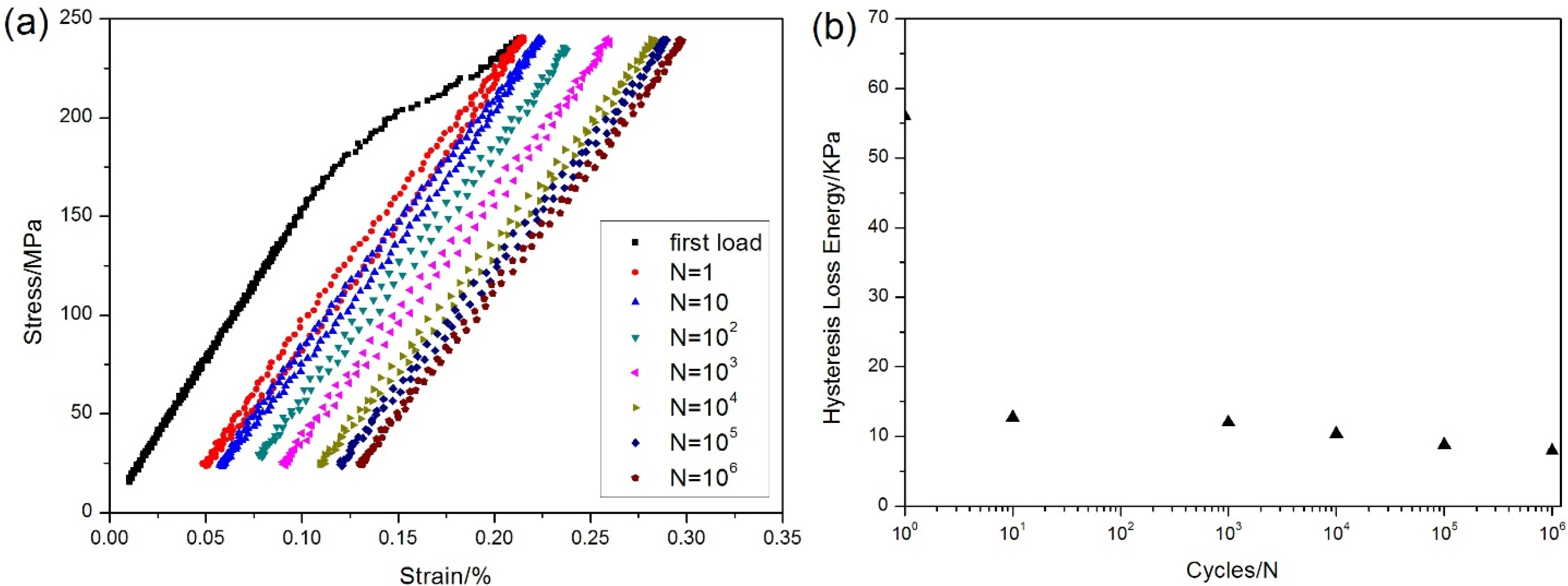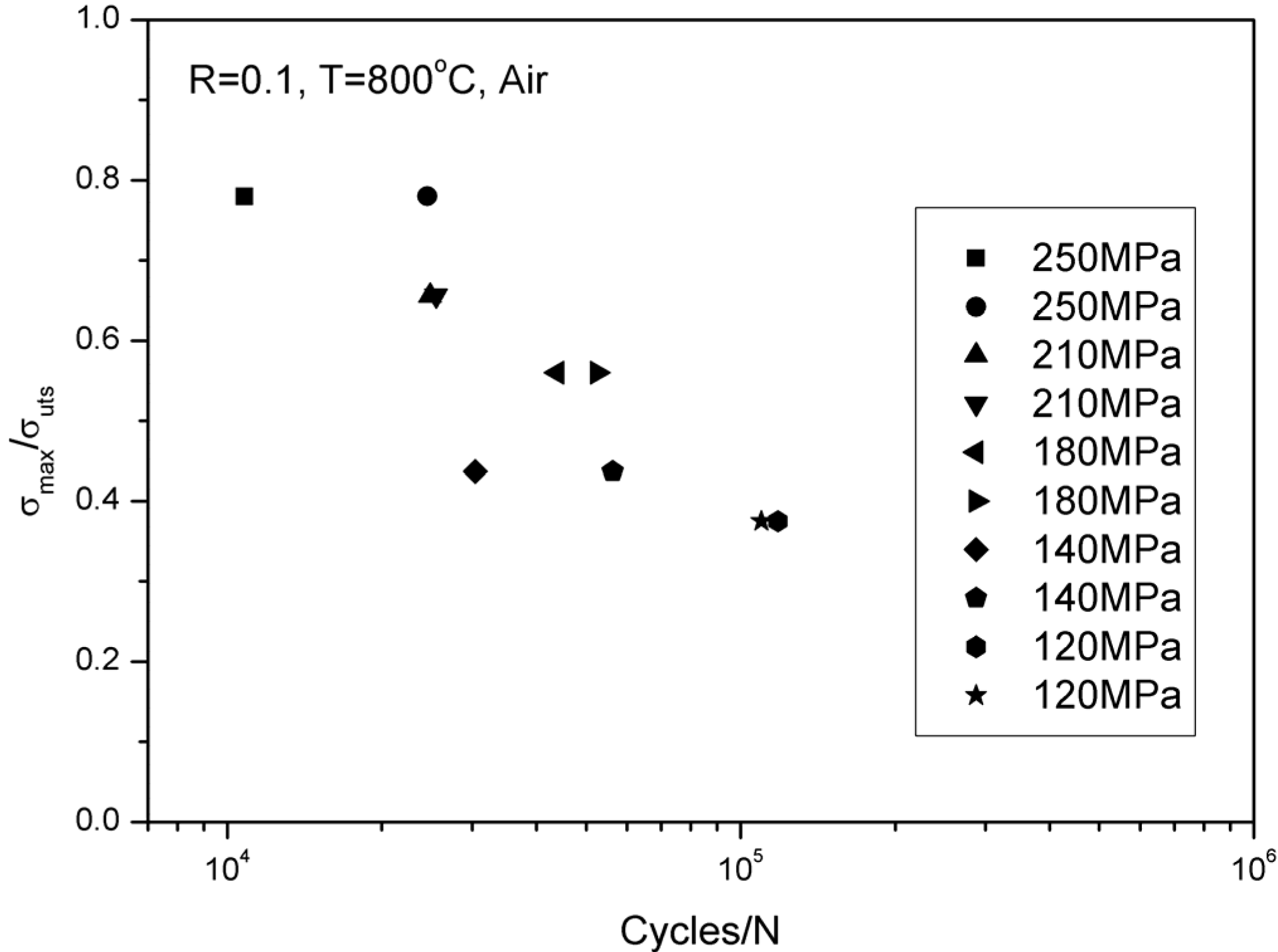Tension-Tension Fatigue Behavior of Unidirectional C/Sic Ceramic-Matrix Composite at Room Temperature and 800 °C in Air Atmosphere
Abstract
:1. Introduction
2. Material Fabrication and Experimental Procedures

3. Experimental Results
3.1. Room Temperature





3.2. Elevated Temperature





4. Fatigue Hysteresis Theories and Life Prediction Model
4.1. Fatigue Hysteresis Theories


4.2. Fatigue Life Prediction Model
5. Experimental Comparisons
5.1. Room Temperature

| Loading cycles | Experimental hysteresis loss energy/KPa | Interface shear stress/MPa |
|---|---|---|
| 1 | 56 ± 3 | 8 ± 0.5 |
| 10 | 12.7 ± 0.5 | 0.40 ± 0.02 |
| 100 | 12.0 ± 0.5 | 0.38 ± 0.02 |
| 10,000 | 10.4 ± 0.5 | 0.35 ± 0.02 |
| 100,000 | 8.8 ± 0.4 | 0.32 ± 0.02 |
| 1,000,000 | 8.0 ± 0.4 | 0.30 ± 0.02 |

5.2. Elevated Temperature

| Loading cycles | Experimental fatigue hysteresis loss energy/KPa | Interface shear stress/MPa |
|---|---|---|
| 1 | 28 ± 2 | 6.1 ± 0.3 |
| 100 | 2.2 ± 0.5 | 0.30 ± 0.02 |
| 10,000 | 1.4 ± 0.5 | 0.22 ± 0.02 |
| 72,200 | 1.2 ±0.5 | 0.20 ± 0.02 |

6. Conclusions
- (1)
- The hysteresis modulus decreases rapidly at the initial stage of fatigue loading due to matrix multicracking and interface debonding. When matrix cracks approach saturation, the decrease of hysteresis modulus would be mainly attributed to interface wear. However, at 800 °C in air, the hysteresis modulus decreases rapidly compared with that at room temperature, due to oxidation of interphase and carbon fibers.
- (2)
- At room temperature, the hysteresis loss energy degrades from 56 KPa during the 1st cycle to 8 KPa during the 1,000,000th cycle; and the interface shear stress degrades from 8 MPa to 0.4 MPa during the first 10 cycles under σmax = 240 MPa; at 800 °C in air, the hysteresis loss energy degrades from 28 KPa during the 1st cycle to 1.22 KPa during the 72,200th cycle; and the interface shear stress degrades from 6.1 MPa to 0.3 MPa during the first 100 cycles under σmax = 120 MPa.
- (3)
- The fatigue limit stress at room temperature was approximately 88% of tensile strength. However, there were no apparent fatigue limit stress at 800 °C in air due to oxidation of interphase or carbon fibers. The fatigue failure specimens were observed under optical microscope. The pullout fibers at 800 °C in air exhibit serious oxidation. At elevated temperature, the degradation of fibers strength due to oxidation of carbon fibers leads to the life being greatly reduced compared with that at room temperature.
- (4)
- The tension-tension fatigue life S-N curves at room temperature and 800 °C under air have been predicted. The predicted fatigue life S-N curve can be divided into two regions, i.e., the first part is affected by the degradation of interface shear stress and fibers strength; and the second part is only affected by fibers strength degradation.
Acknowledgments
Conflicts of Interest
Nomenclature
| σmax | fatigue peak stress; |
| σmin | fatigue valley stress; |
| L | matrix crack spacing; |
| Ld | fiber/matrix interface debonded length; |
| y | unloading interface counter slip length; |
| z | reloading interface new slip length; |
| τi | fiber/matrix interface shear stress; |
| Vf | fiber volume fraction; |
| T | load carried by intact fibers; |
| <Tb> | load carried by broken fibers; |
| P(T) | fibers failure probability; |
| mf | fiber Weibull modulus; |
| σc | fiber characteristic strength; |
| rf | fiber radius; |
| τio | initial fiber/matrix interface shear stress; |
| τimin | final steady-state fiber/matrix interface shear stress. |
References
- Naslain, R. Design, preparation and properties of non-oxide CMCs for application in engines and nuclear reactors: An overview. Compos. Sci. Technol. 2004, 64, 155–170. [Google Scholar] [CrossRef]
- Santhosh, U.; Ahmad, J.; John, R.; Ojard, G.; Miller, R.; Gowayed, Y. Modeling of stress concentration in ceramic matrix composites. Compos. Part B Eng. 2013, 45, 1156–1163. [Google Scholar] [CrossRef]
- Murthy-Pappu, L.N.; Nemeth, N.N.; Brewer, D.N.; Mital, S. Probabilistic analysis of a SiC/SiC ceramic matrix composite turbine vane. Compos. Part B Eng. 2008, 39, 694–703. [Google Scholar] [CrossRef]
- Aveston, J.; Cooper, G.A.; Kelly, A. Single and multiple fracture properties of fiber composites. In Properties of Fiber Composites; IPC Science and Technology Press: Guildford, UK, 1971; pp. 15–26. [Google Scholar]
- Ahn, B.K.; Curtin, W.A. Strain and hysteresis by stochastic matrix cracking in ceramic matrix composites. J. Mech. Phys. Solids 1997, 45, 177–209. [Google Scholar] [CrossRef]
- Ruggles-Wrenn, M.B.; Jones, T.P. Tension-compression fatigue of a SiC/SiC ceramic matrix composite at 1200 °C. Int. J. Fatigue 2013, 47, 154–160. [Google Scholar] [CrossRef]
- Rouby, D.; Reynaud, P. Fatigue behavior related to interface modification during load cycling in ceramic-matrix fiber composites. Comps. Sci. Technol. 1993, 48, 109–118. [Google Scholar] [CrossRef]
- Reynaud, P. Cyclic fatigue of ceramic-matrix composites at ambient and elevated temperatures. Compos. Sci. Technol. 1996, 56, 809–814. [Google Scholar] [CrossRef]
- Holmes, J.W.; Cho, C.D. Experimental observation of frictional heating in fiber-reinforced ceramics. J. Am. Ceram. Soc. 1992, 75, 929–938. [Google Scholar] [CrossRef]
- Cho, C.D.; Holmes, J.W.; Barber, J.R. Estimate of interfacial shear in ceramic composites from frictional heating measurements. J. Am. Ceram. Soc. 1991, 74, 2802–2808. [Google Scholar] [CrossRef]
- Solti, J.P.; Robertson, D.D.; Mall, S. Estimation of interfacial properties from hysteretic energy loss in unidirectional ceramix matrix composites. Adv. Compos. Mater. 2000, 9, 161–173. [Google Scholar] [CrossRef]
- Curtin, W.A. Stress-strain behavior of brittle matrix composites. Compr. Compos. Mater. 2000, 4, 47–76. [Google Scholar]
- Evans, A.G.; Zok, F.W.; McMeeking, R.M. Fatigue of ceramic matrix composites. Acta Metall. Mater. 1995, 43, 859–875. [Google Scholar] [CrossRef]
- Zhu, S.; Mizuno, M.; Kagawa, Y.; Mutoh, Y. Monotonic tension, fatigue and creep behavior of SiC-fiber-reinforced SiC-matrix composites: A review. Compos. Sci. Technol. 1999, 59, 833–851. [Google Scholar] [CrossRef]
- Curtin, W.A. Theory of mechanical properties of ceramic-matrix composites. J. Am. Ceram. Soc. 1991, 74, 2837–2845. [Google Scholar] [CrossRef]
- Saleem, M.; Toubal, L.; Zitoune, R.; Bougherara, H. Investigating the effect of machining processes on the mechanical behavior of composite plates with circular holes. Compos. Part A 2013, 55, 169–177. [Google Scholar] [CrossRef]
- Haddad, M.; Zitoune, R.; Bougherara, H.; Eyma, F.; Castanie, B. Study of trimming damages of CFRP structures in function of the machining processes and their impact on the mechanical behavior. Compos. Part B Eng. 2014, 57, 136–143. [Google Scholar] [CrossRef]
- Shuler, S.F.; Holmes, J.W.; Wu, X.; Roach, D. Influence of loading frequency on the room-temperature fatigue of a carbon-fiber/SiC matrix composite. J. Am. Ceram. Soc. 1993, 76, 2327–2336. [Google Scholar] [CrossRef]
- Staehler, J.M.; Mall, S.; Zawada, L.P. Frequency dependence of high-cycle fatigue behavior of CVI C/SiC at room temperature. Compos. Sci. Technol. 2003, 63, 2121–2131. [Google Scholar] [CrossRef]
- Xia, Z.; Curtin, W.A. Toughness-to-brittle transitions in ceramic-matrix composites with increasing interfacial shear stress. Acta Mater. 2000, 48, 4879–4892. [Google Scholar] [CrossRef]
- Lee, S.S.; Stinchcomb, W.W. Damage mechanisms of cross-ply Nicalon/CAS-II laminate under cyclic tension. Ceram. Eng. Sci. Proc. 1994, 15, 40–48. [Google Scholar]
- Phoenix, S.L.; Raj, R. Scalings in Fracture Probabilities for a Brittle Matrix Fiber Composite. Acta Metall. Mater. 1992, 40, 2813–2828. [Google Scholar] [CrossRef]
© 2015 by the author; licensee MDPI, Basel, Switzerland. This article is an open access article distributed under the terms and conditions of the Creative Commons Attribution license (http://creativecommons.org/licenses/by/4.0/).
Share and Cite
Li, L. Tension-Tension Fatigue Behavior of Unidirectional C/Sic Ceramic-Matrix Composite at Room Temperature and 800 °C in Air Atmosphere. Materials 2015, 8, 3316-3333. https://doi.org/10.3390/ma8063316
Li L. Tension-Tension Fatigue Behavior of Unidirectional C/Sic Ceramic-Matrix Composite at Room Temperature and 800 °C in Air Atmosphere. Materials. 2015; 8(6):3316-3333. https://doi.org/10.3390/ma8063316
Chicago/Turabian StyleLi, Longbiao. 2015. "Tension-Tension Fatigue Behavior of Unidirectional C/Sic Ceramic-Matrix Composite at Room Temperature and 800 °C in Air Atmosphere" Materials 8, no. 6: 3316-3333. https://doi.org/10.3390/ma8063316






